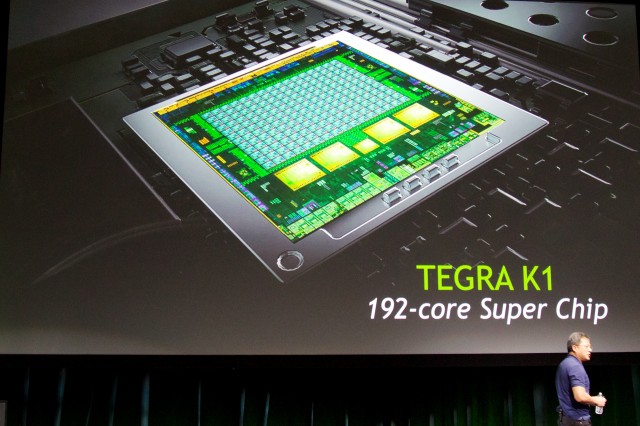Nvidia announces next-generation 64-bit Tegra K1 SoC with 192 GPU cores
Nvidia's new Tegra K1 SoC.
Lee Hutchinson
Nvidia unveiled the next-generation version of its Tegra system-on-a-chip tonight at its CES press conference. The new Tegra K1 has two important selling points. The first is that it uses a GPU with 192 CUDA cores based on Nvidia's Kepler GPU architecture, the same used in the desktop GeForce GT 600 and 700-series GPUs. Secondly, some versions of the chip will be the first to ship with Nvidia's custom "Denver" ARM CPU, a 64-bit architecture that supports the ARMv8 instruction set.
Combining its desktop and mobile GPU architectures has been on Nvidia's roadmap for some time now, as we saw at the company's GPU Technology Conference in March of 2013. The difference is that now we have some idea of just how powerful that GPU will be: at 192 CUDA cores, the Tegra K1 has roughly the same raw processing horsepower as a GeForce GT 630 or 635, a low-end dedicated GPU from early last year. Memory bandwidth and throttling will also affect performance, but this gives us a decent idea of where Tegra K1 is relative to Nvidia's desktop cards.
Nvidia CEO Jen-Hsun Huang spent a fair chunk of time talking about the benefits of using the same GPU architecture across both PCs and mobile devices. Since the Tegra K1 supports the same API levels and hardware features as a full GeForce GPU, game and middleware developers will theoretically have an easier time porting their engines from desktops and game consoles to phones and tablets. Nvidia's current Tegra GPUs don't support newer APIs like OpenGL ES 3.0, so support for the full version of OpenGL 4.4 is a nice leap forward.
Read 4 remaining paragraphs | Comments





Andrew Cunningham
Mon, 06 Jan 2014 06:25:54 GMT
No comments:
Post a Comment